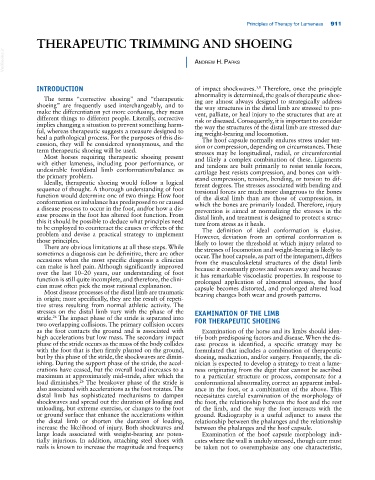Page 945 - Adams and Stashak's Lameness in Horses, 7th Edition
P. 945
Principles of Therapy for Lameness 911
THERAPEUTIC TRIMMING AND SHOEING
VetBooks.ir anDrew h. ParKS
INTRODUCTION of impact shockwaves. Therefore, once the principle
3,8
abnormality is determined, the goals of therapeutic shoe-
The terms “corrective shoeing” and “therapeutic ing are almost always designed to strategically address
shoeing” are frequently used interchangeably, and to the way structures in the distal limb are stressed to pre-
make the differentiation yet more confusing, they mean vent, palliate, or heal injury to the structures that are at
different things to different people. Literally, corrective risk or diseased. Consequently, it is important to consider
implies changing a situation to prevent something harm- the way the structures of the distal limb are stressed dur-
ful, whereas therapeutic suggests a measure designed to ing weight‐bearing and locomotion.
heal a pathological process. For the purposes of this dis- The hoof capsule normally endures stress under ten-
cussion, they will be considered synonymous, and the sion or compression, depending on circumstances. These
term therapeutic shoeing will be used. stresses may be longitudinal, radial, or circumferential
Most horses requiring therapeutic shoeing present and likely a complex combination of these. Ligaments
with either lameness, including poor performance, or and tendons are built primarily to resist tensile forces,
undesirable foot/distal limb conformation/balance as cartilage best resists compression, and bones can with-
the primary problem. stand compression, tension, bending, or torsion to dif-
Ideally, therapeutic shoeing would follow a logical ferent degrees. The stresses associated with bending and
sequence of thought. A thorough understanding of foot torsional forces are much more dangerous to the bones
function would determine one of two things: How foot of the distal limb than are those of compression, in
conformation or imbalance has predisposed to or caused which the bones are primarily loaded. Therefore, injury
a disease process to occur in the foot, and/or how a dis- prevention is aimed at normalizing the stresses in the
ease process in the foot has altered foot function. From distal limb, and treatment is designed to protect a struc-
this it should be possible to deduce what principles need ture from stress as it heals.
to be employed to counteract the causes or effects of the The definition of ideal conformation is elusive.
problem and devise a practical strategy to implement However, deviation from an optimal conformation is
those principles. likely to lower the threshold at which injury related to
There are obvious limitations at all these steps. While the stresses of locomotion and weight‐bearing is likely to
sometimes a diagnosis can be definitive, there are other occur. The hoof capsule, as part of the integument, differs
occasions when the most specific diagnosis a clinician from the musculoskeletal structures of the distal limb
can make is heel pain. Although significantly improved because it constantly grows and wears away and because
over the last 10–20 years, our understanding of foot it has remarkable viscoelastic properties. In response to
function is still quite incomplete, and therefore, the clini- prolonged application of abnormal stresses, the hoof
cian must often pick the most rational explanation. capsule becomes distorted, and prolonged altered load
Most disease processes of the distal limb are traumatic bearing changes both wear and growth patterns.
in origin; more specifically, they are the result of repeti-
tive stress resulting from normal athletic activity. The
stresses on the distal limb vary with the phase of the EXAMINATION OF THE LIMB
stride. The impact phase of the stride is separated into
26
two overlapping collisions. The primary collision occurs FOR THERAPEUTIC SHOEING
as the foot contacts the ground and is associated with Examination of the horse and its limbs should iden-
high accelerations but low mass. The secondary impact tify both predisposing factors and disease. When the dis-
phase of the stride occurs as the mass of the body collides ease process is identified, a specific strategy may be
with the foot that is then firmly planted on the ground, formulated that includes a combination of therapeutic
but by this phase of the stride, the shockwaves are dimin- shoeing, medication, and/or surgery. Frequently, the cli-
ishing. During the support phase of the stride, the accel- nician is expected to develop a strategy to treat a lame-
erations have ceased, but the overall load increases to a ness originating from the digit that cannot be ascribed
maximum at approximately mid‐stride, after which the to a particular structure or process, compensate for a
load diminishes. The breakover phase of the stride is conformational abnormality, correct an apparent imbal-
26
also associated with accelerations as the foot rotates. The ance in the foot, or a combination of the above. This
distal limb has sophisticated mechanisms to dampen necessitates careful examination of the morphology of
shockwaves and spread out the duration of loading and the foot, the relationship between the foot and the rest
unloading, but extreme exercise, or changes to the foot of the limb, and the way the foot interacts with the
or ground surface that enhance the accelerations within ground. Radiography is a useful adjunct to assess the
the distal limb or shorten the duration of loading, relationship between the phalanges and the relationship
increase the likelihood of injury. Both shockwaves and between the phalanges and the hoof capsule.
large loads associated with weight‐bearing are poten- Examination of the hoof capsule morphology indi-
tially injurious. In addition, attaching steel shoes with cates where the wall is unduly stressed, though care must
nails is known to increase the magnitude and frequency be taken not to overemphasize any one characteristic,

